As one SC island grows ever bigger, its counterpart fights to hold onto the sand it has left
Around the world, coastal residents often live in terror of beach erosion, threatening the safety of their homes as the ocean slowly claims them.
In South Carolina, Sullivan’s Island doesn’t have that problem. For decades, the barrier island actually has been growing, thanks to the Charleston port’s jetties. Built in 1886, the jetties protect the port from quickly filling up with silt and sand as the tides come in and, in turn, funnel that sand to Sullivan’s.
Some see those jetties as a gift, giving new life to the island’s maritime forest and allowing it to grow as never before. As residents and visitors walk from the beach back inland, they can watch the stages of forest succession, something most have likely only seen in the pages of a biology textbook in school. The forest and the dunes in front of it also protect homes from hurricanes and flooding.
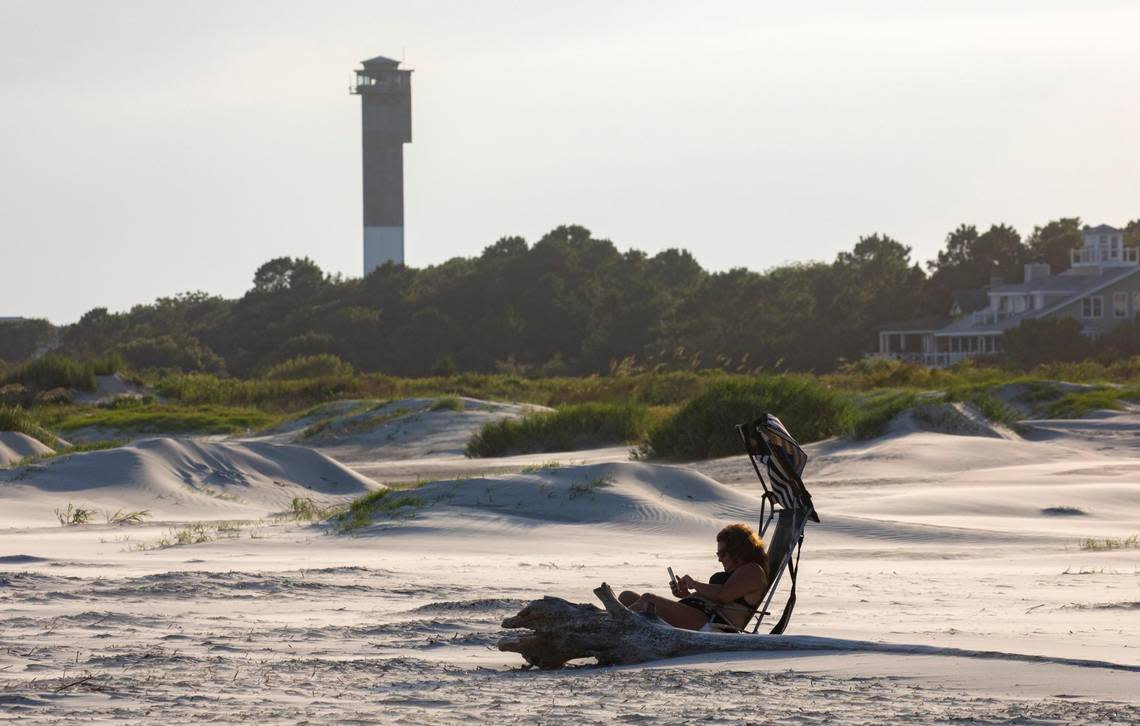
Sullivan’s gift, however, is Folly Beach’s curse.
That sand accumulating on Sullivan’s Island should be moving south to Morris Island and then to Folly Beach. But because of the jetties, the sand stays trapped on Sullivan’s. The jetties have also produced unnatural currents that have eroded Folly’s beaches even faster.
At the same time, some Sullivan’s Island homeowners are livid that their oceanfront views are blocked by the growing maritime forest. Many of the homes have two or three stories, but even the top floor doesn’t have what one might call “the best” view of the water.
One person even went so far as to chop down nearly 100 trees in front of their home to improve the view, which is illegal and could result in prison time under South Carolina law. The home was later sold for more than $2 million than it was originally bought for — and that was before the pandemic led to skyrocketing home values.
Folly Beach and Sullivan’s Island are a tale of two beach towns. Sitting across the harbor from one another, across the jetties, they both want the same thing — to protect their beaches. If the jetties didn’t exist, Folly wouldn’t erode as rapidly as it does and Sullivan’s wouldn’t be growing to the point that oceanfront homeowners are enraged.
The jetties — the lifeblood of the booming Charleston port — aren’t going anywhere. And a permanent solution to the problems facing Sullivan’s and Folly remains elusive as they deal with the unending consequences of a decision made for them 135 years ago.
Back to the beginning
Folly Beach first began to disappear in the 1950s, after the ocean had eroded Morris Island into nothing just to the north.
With Morris Island out of the way, the ocean’s wrath turned on Folly Beach.
All it took was a few decades for Folly’s coastline to all but disappear. Waves were lapping at the sea wall.
“Throughout the golden era here, we had a big wide beach,” Folly Beach mayor Tim Goodwin said. “In the ‘60s, ‘70s and ‘80s, the beach basically went away. At high tide the beach just disappeared. ... People would wait for high tide and jump off the sea wall and play in the waves.”
In those past decades, Folly Beach was widely known as a place to avoid, Goodwin said. The lack of a beach had decimated the city’s economy. The island then attracted crime, making it more and more unsafe as time went on.
“My husband grew up in Mount Pleasant and wasn’t allowed to go to Folly,” said Nicole Elko, an engineer who studies beach erosion for Folly.
Elko said the erosion can be hard for locals to notice because it’s a very gradual change. Though, the change has been speeding up with sea level rise.
“After a big storm or maybe two or three ‘king tides’ back to back, that is when you notice the biggest part of it,” Goodwin said.
Folly Beach had its first beach renourishment in 1979, but it spanned just 1,500 feet, a fraction of what the town needed. A decade and a half later, in 1993, the first major renourishment project was completed. It covered 5.3 miles, 90% of the town’s length. Nearly 2.7 million cubic yards of sand were put onto Folly Beach’s shores.
The U.S. Army Corps of Engineers, the agency that built the jetties causing Folly Beach’s erosion problems more than a century earlier, paid 85% of the $12.5 million project.
Renourishment does more than just restore the beach, though. The Corps of Engineers sees renourishment as a risk reduction project. By restoring the beach now, taxpayers are saved millions, even billions of dollars later in storm damage.
That’s the solution, if it can be called that, for Folly Beach. Replace the sand when it inevitably washes away without a trace. And then do it again, and again, and again.
Another solution being looked into by the Corps of Engineers is to build a sandbar off the coastline of Folly Beach that the ocean can naturally use to feed the island sand. But that is another temporary solution.
And a sandbar could potentially ruin something Folly Beach is known for — surfing — by stealing energy from the waves before they reach the shoreline, shrinking the swells surfers rely on.
Regardless of the sandbar’s impact, surfing has been a dwindling part of life on the island for a while, because the “Washout,” an area that gets the best waves, has been disappearing for years.
“That’s where people go and surf, and that definitely (erodes) away,” Folly Beach resident Tift Mitchell said. “So it depresses not only just a lifestyle perspective from just going out and enjoying the beach to” the literal uses of the island.
Mitchell said the erosion even makes Folly feel more isolated. “It’s a shame,” he said.
A growing, not eroding, beach
For every problem Folly Beach has with erosion, Sullivan’s Island has the opposite dilemma.
“I kid with the mayor of Sullivan’s Island that I’m going to send him a bill for the sand he’s collecting up there,” Goodwin said.
Most of Sullivan’s Island is growing rather than shrinking. The beaches have grown so much that it’s rare to see beachgoers without a cart to drag their bags and chairs. When you’re walking a quarter-mile or more just to get a glimpse of the water, all of those “beach essentials” get a lot heavier.
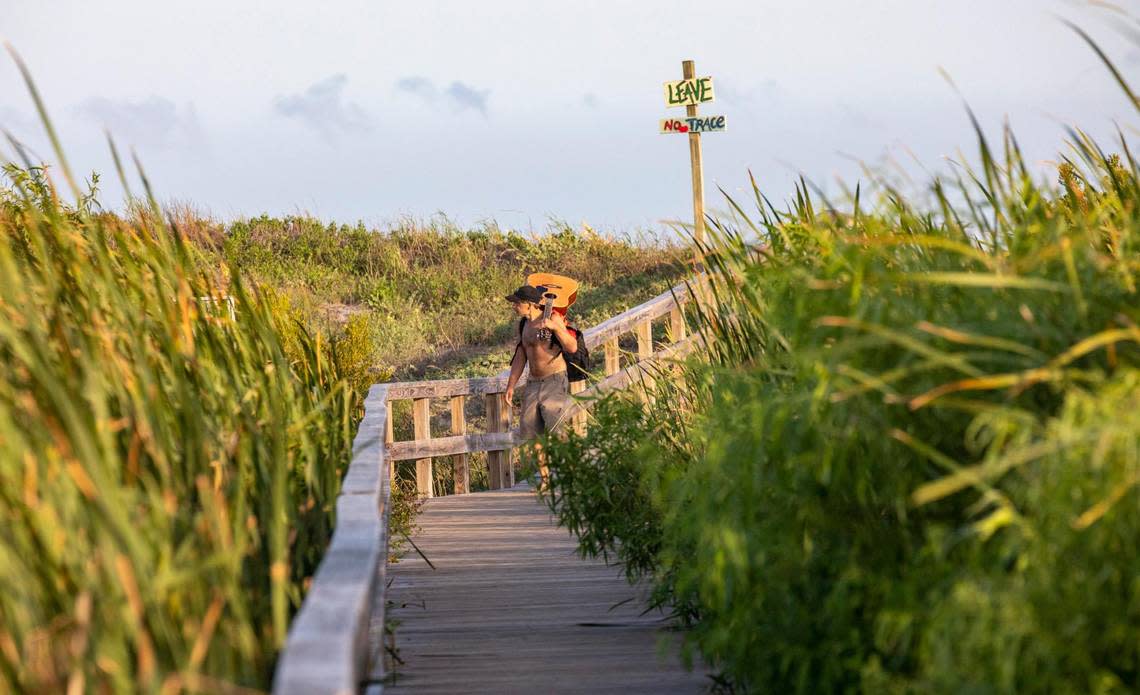
The island doesn’t need the groins Folly Beach uses to hold onto the little sand it has. Beach renourishment projects have always been relatively minimal at Sullivan’s, and erosion is primarily a problem in the middle of the island, where a submerged sandbar is holding onto sand that the actual coastline needs, and at the northernmost point of the island, where sand is stolen by Breach Inlet.
In the last few decades alone, Sullivan’s Island’s beach has grown by dozens of feet. Walking from the beach inland along the access points is like entering a time capsule. Each stage of dune succession is visible, from sea oats to shrubs to the trees that make up the island’s growing maritime forest.
Many homeowners love the trees, particularly when it comes to storm protection. Hurricane Ian slammed into South Carolina, just north of Sullivan’s Island, in fact, and it was a walk in the park for the island residents.
“We are truly blessed to be able to have such a protective barrier between the ocean and the homes here on the island that others don’t,” Sullivan’s Island resident Karen Byko said.
Byko is president of the group Sullivan’s Island for All, which advocates on behalf of the maritime forest and its benefits to the town. She said the forest doesn’t just protect the island from hurricanes — it literally holds the island itself together.
“The roots of those trees and shrubs are really holding this island together because at the end of the day, when we think about it, a barrier island is just a sandbar that has soil island placed on top,” said Byko, who grew up in the Bahamas and watched how hurricanes steadily ripped her island home to pieces. “It’s held together by the roots of trees and shrubs. You can really see how that works after you have a storm and you go to the beach and you see how we’ve held together versus eroding like other islands.”
Visitors love the trees, too, but it isn’t without reservation. Michael Barnett, a resident of nearby Mount Pleasant, knows that everything he loves about Sullivan’s Island comes at a cost.
“It’s fine for me, for people who love wildlife and love this area and love the island the way it is,” he said. “It’s devastating for other areas. What’s good for Sullivan’s has been a negative for Morris Island and Folly Beach.”
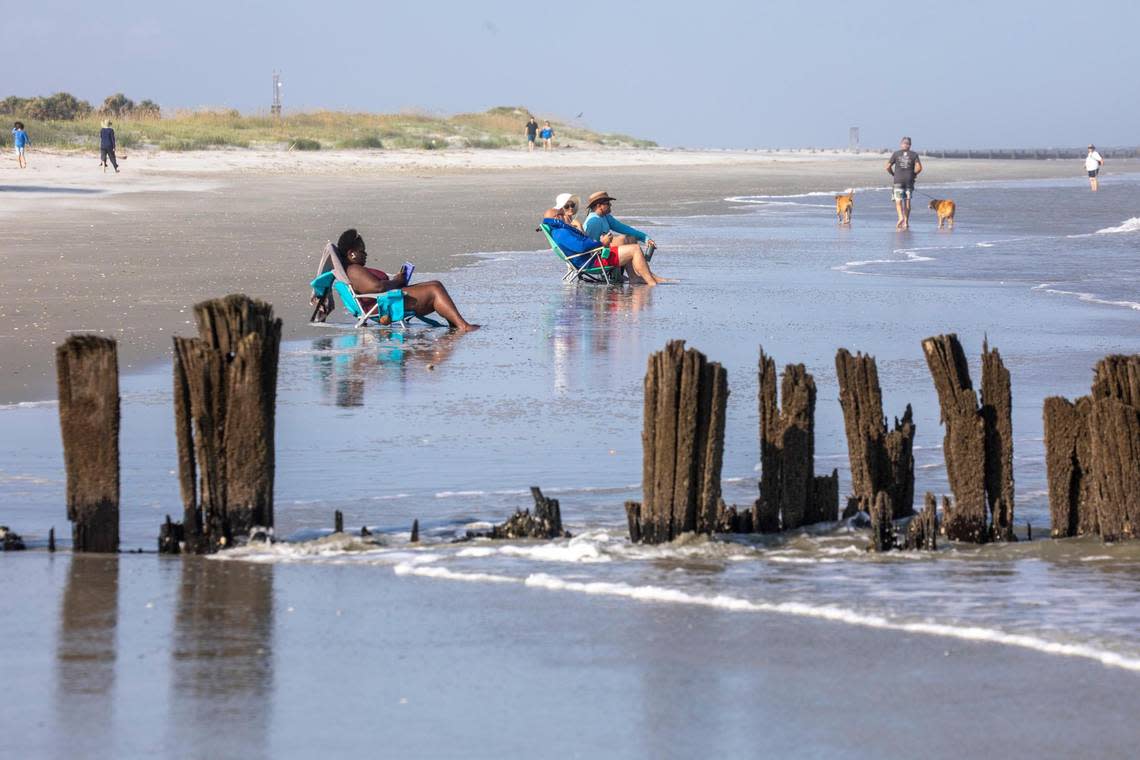
Sullivan’s Island isn’t the only place that benefits from Folly Beach’s struggles. Kiawah Island, just south of Folly, doesn’t have to worry about erosion as much because the sand from Folly’s renourishment projects ultimately ends up on Kiawah.
“Folly is withering away to nothing,” said Elko, the engineer who studies beach erosion for Folly. “Kiawah is somewhat protected ... and Folly has put millions of cubic yards of sand on the beach since the ‘90s, and it’s good to be downdraft.”
A feat of nature that some residents hate
The result of Sullivan’s Island’s growing beaches has been a feat coastal scientists around the world wish for: The return of a maritime forest in a place that was deforested for the sake of human development.
South Carolina’s maritime forests are scarce, and the entities that control them fight to protect them.
Visitors to Myrtle Beach State Park, for example, must stick to the existing trails and not stray beyond them. Farther up the coastline, the Waties Island maritime forest is strictly controlled by Coastal Carolina University. Outsiders are rarely given access to the undeveloped barrier island.
Realizing the ecological treasure on its hands, Sullivan’s Island created a conservation easement in 1991 to protect it.
“I think most people on the island appreciate it. Most people see it as a valuable resource,” Sullivan’s Island Mayor Pat O’Neil said. “And it’s reflected in the property values here. When you look at the prices of properties on this island, there doesn’t seem to be any ceiling currently.
“We don’t gloat, but we’re very pleased that we have what we have and grateful, and we always tell people, ‘Thank God and the Corps of Engineers.’”
Dana Beach, the founder of the Coastal Conservation League, called the growth of Sullivan’s forest “amazing” but admitted its appearance has been awkward, to say the least.
“We are a funny species,” he said. “We just complain about everything, so the beach is ‘too big’ at Sullivan’s now because it’s grown out, and now there’s a maritime forest that blocks the view of the front beach houses.”
Sullivan’s does not allow development any closer to the coastline than already exists, even though selling public land could generate millions of dollars for the island. And people are generally forbidden from traipsing through most of the maritime forest, save for a few trails on the south end of the island.
These rules have heightened tensions and frustrated some homeowners who expected their oceanfront homes would have views of the ocean, only to have that view blocked by trees.
Steve Poletti, a physician and Sullivan’s Island resident, criticized the maritime forest in a 2021 column for the Post & Courier, saying it’s anything but a “marvel of nature.”
“The only thing the opponents want to preserve is conflict and hostility, and their vitriol has poisoned our island community,” Poletti continued.
Over the years, the tension led to a lawsuit against the city and caused some property owners to take matters into their own hands. One home, at the corner of Station 26 and Atlantic Avenue, was bought in the mid-2010s and during remodeling had nearly 100 trees cut down in front of it, despite the property line for the home stopping well before the tree line. There was no legal consequence for the property owner who cut those trees.
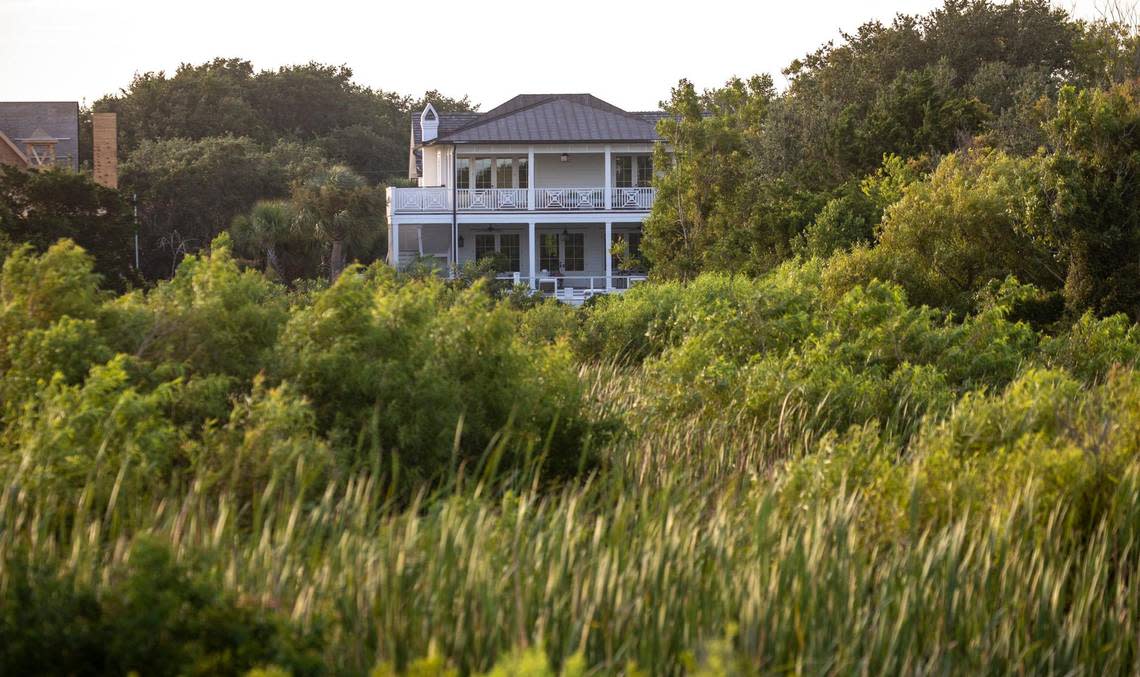
Back then, the town was still pursuing a more conciliatory approach to forest preservation. Town leaders wanted to educate people about the need to protect the trees and the consequences of cutting them down.
But words alone don’t seem to be enough, O’Neil said. Town leaders are now issuing stronger threats and even threatening felony charges for more extensive acts of environmental damage. Cutting down even four or five trees could easily meet the threshold for a criminal charge of felony property damage.
“It’s the town’s intention to protect those trees in every way possible,” O’Neil said. “The ability to charge someone with a felony — that changes the consequences quite a bit. If you’re an attorney or a physician, that’s a serious charge. You can’t own a gun. You can’t vote for a time.”
“If you pick up a million dollars on your home sale, why wouldn’t you spend a few thousand on a fine,” Sullivan’s Island town manager Andy Benke said said. “It picks up a different twist if you’re a convicted felon.”
Raising the penalties will be a deterrent, O’Neil hopes, but he also admits that there’s only so much the town can do. With 200 acres of forested land along the coastline, there’s only so much the police force serving a town of 2,100 people can realistically keep an eye on. As a result, O’Neil said, tree cutting, although usually in limited amounts, is happening “all the time.”
O’Neil just wishes the people who hate the trees thought about the benefits the dunes, the marshes and the forest offer the town’s residents. Storm surges, one of the most devastating impacts a hurricane can have, really aren’t a problem for much of Sullivan’s Island.
“People typically underestimate the force that moving water has,” O’Neil said.
Benke has also just run out of patience, in some ways, for the homeowners who want to chop down the trees in front of their houses. Yes, the trees get in the way somewhat, but as he walked the beach, pointing out one house after another, Benke pointed out that if he could see people in their houses, then they could see him on the beach.
“It’s difficult to convince me that these houses have a hardship seeing the ocean,” he added.
‘Tale of two beaches’
Dana Beach, the Coastal Conservation League founder, called the issues facing Folly Beach and Sullivan’s Island a “tale of two beaches.”
“You’ve got Sullivan’s with vicious legal warfare, and Folly you’ve got the opposite where people are desperately trying to figure out how to get enough money to put sand in front of the houses so the houses don’t fall into the ocean,” he said.
Is there a way to help both islands?
The short answer: No.
The only way to change the course of the ocean (literally), to change the way it affects these islands, would be to remove the Charleston jetties. But that’s not happening.
“We know they’re not going to take the jetties out,” Goodwin said. “They just deepened the harbor.”
All that’s left to do is learn to live with the consequences.
Cavalierly, Beach did note one ultimate solution: “Get as far away from the beaches as possible. But humans don’t take that rational approach because of the value of real estate.”
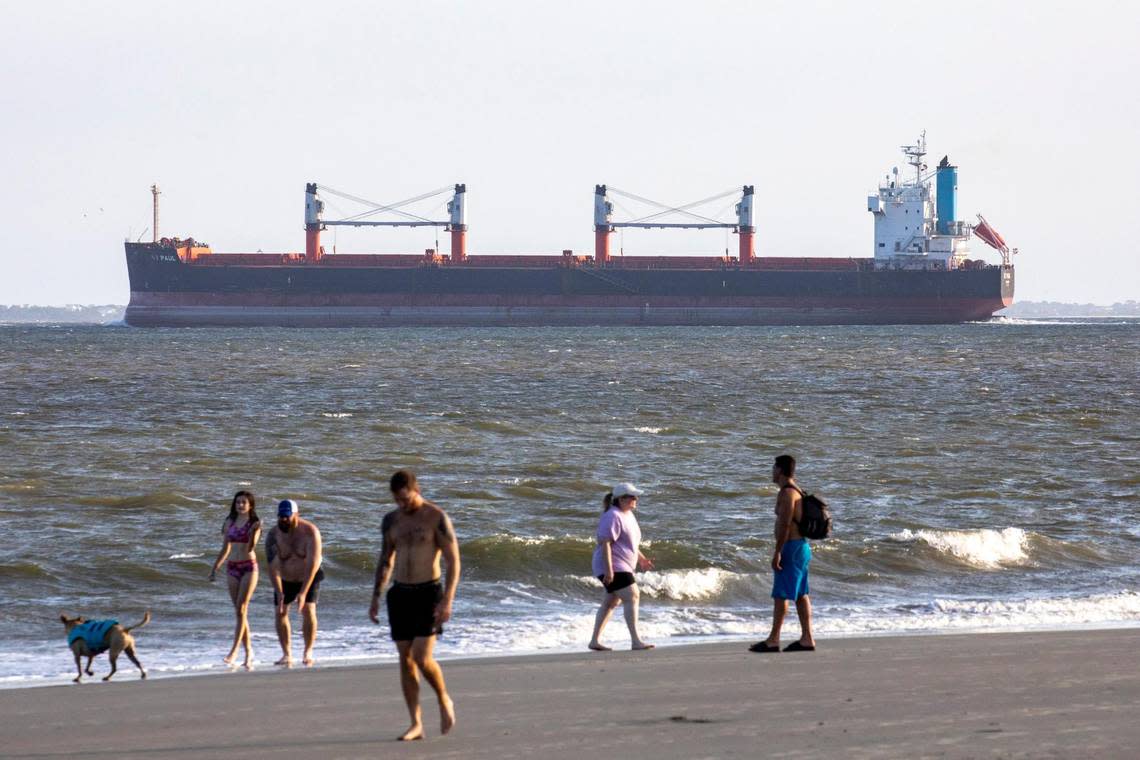
Is there a solution?
Folly Beach is doing its best, Goodwin, the city’s mayor, says. Beach renourishment is a sort of permanently temporary solution to a largely unsolvable problem. Right now, the barrier island is planning for another renourishment in 2024 or a few years after. The only change, if any, Goodwin could really ask for is a better use of the sand that gets periodically dredged out of the Charleston port.
“Why not throw it over the jetty? Even a couple grains would help,” said Elko, the Folly Beach engineer.
Even though constantly throwing sand back on the beach might not feel like a permanent solution, Elko said, it’s the most permanent solution the town has, no matter how many times that sand washes away into the ocean.
“If we stop renourishing, Folly Beach is going to fall into disrepair again,” Elko said. “The beach is the economy here. People don’t come here to go to the stores.”
In interviews earlier this summer, Elko and Goodwin said the town expected that it wouldn’t need to do beach renourishment for a few more years. Hurricane Ian threw those plans into the trash. Elko now says the town suspects emergency renourishment will be necessary to protect the island after losing “quite a lot” of its dunes.
Maintaining the beach on Folly does more than just help the tourism industry.
“We didn’t have turtle nesting when it was just the seawall,” Elko said.
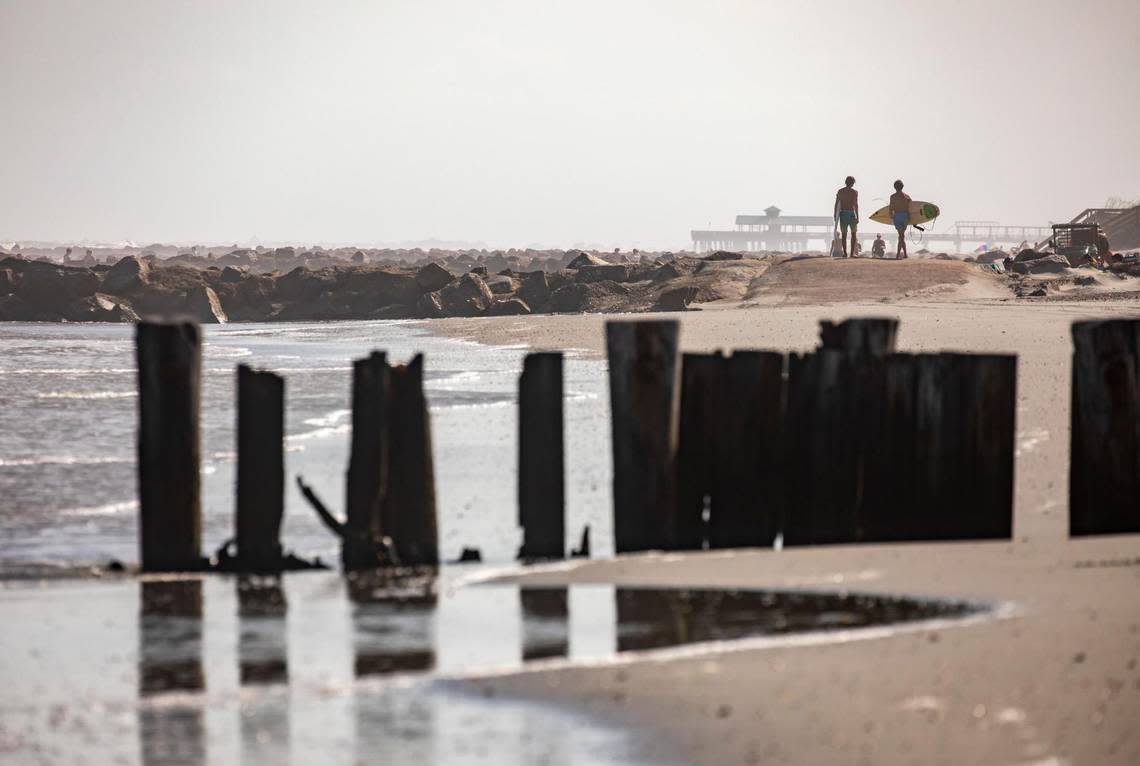
The impact isn’t just environmental. You don’t have to be a turtle lover to understand, Goodwin said. “If you lose the beach, and you lose the business driver here ... there are thousands of jobs that go behind that. It’s not just some rich guys who are going to have a house on the front of the beach. There won’t be the electricians, plumbers, plane tickets.”
The residents of the town don’t really mind the solution, especially considering they don’t have to pay for it. The Corps of Engineers recently upgraded the percentage it pays for renourishment to 90% from 85%. The remaining 10% is split between state funding and local accommodations taxes the town charges visitors. The town’s 2,600 residents don’t pay a dime directly.
As for Sullivan’s, while most cities in major metros are struggling to figure out how to manage “growth” — of their economies and populations — Sullivan’s Island is trying to figure out how to manage a more literal form of growth, that of a forest.
The solution for Sullivan’s Island will come in many parts — ensuring the strength of the conservation easement that covers the forest, issuing stronger fines and penalties for damage to the forest, and teaching residents about how the forest is a benefit, not a detriment to the island.
Yet it’s unclear whether the island is entirely willing to listen. In 2019, a council majority willing to acquiesce to the anti-forest cohort was elected by just one vote. That council then pursued a settlement in the lawsuit involving the forest which involved clear cutting vegetation and canopying many of the taller trees.
Town Council member Greg Hammond was one of the people who voted in support of the settlement. While he said he hopes the town can soon move past a lot of the tension related to it, he said he believed the settlement was a “fair compromise.” In his view, the settlement only allows just enough tree trimming to ensure the beachfront homeowners could maintain their views of the ocean and let the sea breeze through.
“I, frankly, thought that that was a pretty reasonable compromise,” Hammond said.
But right after the settlement was finalized, whiplash. A pro-forest council majority was restored in a 2021 election. The new council has sued to stop the settlement’s implementation.
“In Sullivan’s Island politics, we don’t have R’s and D’s — Republicans and Democrats,” O’Neil said. “We have tree cutters and tree huggers.”
O’Neil believes the “tree huggers” won back control in a landslide election as a sign that the “tree cutters” were not actually what the town wanted. All of the seats on the council are at-large, so it’s easy to read that as the conclusion of the election results.
But another election could change it all.
